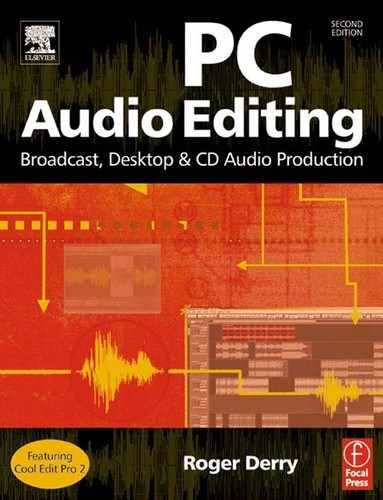Preface
For years PCs struggled hard to cope with the prodigious demands of handling audio, let alone doing it well, or at any speed. Nowadays ‘entry-level’ PCs can provide facilities that, in previous decades, professional audio technicians would have killed for. Indeed, there is no doubt that a contemporary 6-year-old could happily edit audio on a PC. But, as always with most skills, the trick is NOT doing it like a 6-year-old child.
This book is aimed at people who wish to make audio productions for issue as recordings, or for broadcast, using a Windows PC with material acquired using portable equipment, as well as in studios. There are already plenty of books on music technology; this one is aimed at people who want to use speech as well – the making of cassette sales promotions, radio programmes or even Son et Lumière! The book does not expect you to be a technician, although if you are there will still be plenty to interest you, as the book includes production insights to help you use your PC for producing audio productions in the real world.
Even those who are experienced in editing and mixing with quarter-inch tape can find the change to editing audio visually on a PC daunting. However, while this does bring a change of skills, most of the new skills are more easily learned.
Visual editing is done statically rather than having to use the arcane dynamic skills of ‘scrub’ editing required by quarter-inch tape. Hearing an edit while scrubbing the tape back and forth was a skill that took weeks or even months to perfect. Some were doomed never to be able to hear clearly. With the PC, making mistakes is far less of a problem; correcting errors is rapid, and safe, unlike unpicking bits of tape spliced with sticky tape.
The author’s early career included being a specialist tape editor. He is now a convert to the use of a PC for editing. His career has included all the jobs that go to make a radio programme, including production, reporting, management, studio and location technical operations (and fetching tea!). He can therefore offer advice and experience over the whole range of audio production.
This book is not a manual for a particular PC editor, although it is firmly based on the widely used Cool Edit Pro. This second edition uses version 2, which has been developed since the first edition was published. Cool Edit 2, a cheaper, reduced facility program, has also been produced since then. In its basic form it is a wave editor with reduced facilities. Extra modules can be bought to bring it up to a program that can do much of what is possible with the Pro version. There are, at the time of writing, some cosmetic differences between the two programs, but the operating techniques are very similar. This book has been written using a late ‘beta’ version of Cool Edit Pro version 2, and there may be minor changes in the published version as well as in any later revisions.
The book attempts to show the basic principles of the new technology. While each of the many audio editors that exist have their operational differences, basic principles remain constant. Many aspects of Cool Edit Pro are described in detail. Yet, audio is audio. Digits are digits. Other programs may implement any task differently, better or worse, but the principles behind those operations remain the same.
Since the first edition PCs have become even faster, and with this speed new facilities have become feasible. The most notable is the ability to use ‘real-time’ effects such as equalization and reverberation. Cool Edit Pro makes full use of this with almost all of its Effects transforms available in real time as well as for changing audio files permanently. It also features a useful ‘half-way house’ where real-time effects can be ‘locked’. When this is done a preprocessed version of the track is created, thus reducing the amount of processor power required to play a multitrack recording.
